Zuni religion is the oral history, cosmology, and religion of the Zuni people. The Zuni are a Pueblo people located in New Mexico. Their religion is integrated into their daily lives and respects ancestors, nature, and animals. Because of a history of religious persecution by non-native peoples, they are very private about their religious beliefs. Roman Catholicism has to some extent been integrated into traditional Zuni religion.

The Zuni are Native American Pueblo peoples native to the Zuni River valley. The Zuni people today are federally recognized as the Zuni Tribe of the Zuni Reservation, New Mexico, and most live in the Pueblo of Zuni on the Zuni River, a tributary of the Little Colorado River, in western New Mexico, United States. The Pueblo of Zuni is 55 km (34 mi) south of Gallup, New Mexico. The Zuni tribe lived in multi level adobe houses. In addition to the reservation, the tribe owns trust lands in Catron County, New Mexico, and Apache County, Arizona. The Zuni call their homeland Halona Idiwan’a or Middle Place. The word Zuni is believed to derive from the Western Keres language (Acoma) word sɨ̂‧ni, or a cognate thereof.

Zuni is a language of the Zuni people, indigenous to western New Mexico and eastern Arizona in the United States. It is spoken by around 9,500 people, especially in the vicinity of Zuni Pueblo, New Mexico, and much smaller numbers in parts of Arizona.

Amaranthus blitoides, commonly called mat amaranth, prostrate pigweed, procumbent pigweed, prostrate amaranth, or matweed, is a glabrous annual plants species. It usually grows up to 0.6 m, though it may grow up to 1 m. It flowers in the summer to fall.
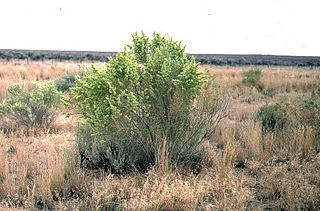
Atriplex canescens is a species of evergreen shrub in the family Amaranthaceae native to the western and midwestern United States.

Cycloloma is a monotypic genus which contains the sole species Cycloloma atriplicifolium, which is known by the common names winged pigweed, tumble ringwing, plains tumbleweed, and tumble-weed. This plant is native to central North America, but it is spreading and has been occasionally reported in far-flung areas from California to Maine to the Canadian prairie. It is considered an introduced species outside of central North America. This is a bushy annual herb forming a rounded pale green clump which may exceed 0.5 m in height. It is very intricately branched, with toothed leaves occurring near the base. The spreading stems bear widely spaced flowers are small immature fruits fringed with a nearly transparent membranous wing. In autumn, the plant forms a tumbleweed. The fruit is a utricle about 2 millimeters long containing a single seed.
The Blackwater Ecological Preserve is a 318-acre (129 ha) Natural Area Preserve located in the area of Zuni, Virginia and owned by Old Dominion University. It is home to flatwoods of longleaf pine and turkey oak and savannas of longleaf pine, two of the rarest plant communities in Virginia. The longleaf pine savanna is the northernmost natural occurrence of such a plant community in the United States. Research on longleaf pine survival rates are currently being performed by Old Dominion University.
Eriogonum jamesii is a species of wild buckwheat known by the common name James' buckwheat and antelope sage. It is native to the southwestern United States, being found in: Colorado, Utah, Arizona, Texas, New Mexico, Oklahoma, and Nebraska.
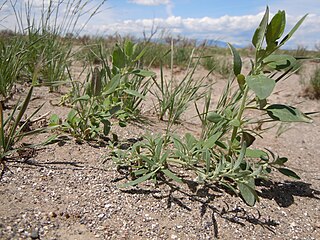
Chenopodium leptophyllum is a species of flowering plant in the family Amaranthaceae known by the common name narrowleaf goosefoot.

Orobanche fasciculata is a species of broomrape known by the common name clustered broomrape. It is native to much of western and central North America from Alaska to northern Mexico to the Great Lakes region, where it grows in many types of habitat. It is a parasite growing attached to the roots of other plants, usually members of the Asteraceae such as Artemisia; and other genera such as Eriodictyon and Eriogonum. This plant produces one or more stems from a bulbous root, growing erect to a maximum of about 20 centimeters in height. The stems, leaves and five-lobed flowers are covered by sticky hairs. As a parasite taking its nutrients from a host plant, it lacks chlorophyll as well as a water-storage system. It is variable in color, often yellowish or purple. The inflorescence is a raceme of up to 20 flowers, each on a pedicel up to 15 centimetres long. Each flower has a calyx of hairy triangular sepals and a tubular corolla 1.5–3 cm long. The flower is yellowish or purplish in color.
Calliandra humilis, the dwarf stickpea, is a species of flowering plants of the genus Calliandra in the family Fabaceae.

Zinnia grandiflora is a species of flowering plant in the family Asteraceae known by the common names Rocky Mountains zinnia and plains zinnia. It is native to the southwestern and south-central United States and northern Mexico.
Asclepias involucrata, common name dwarf milkweed, is a plant found in the American southwest.
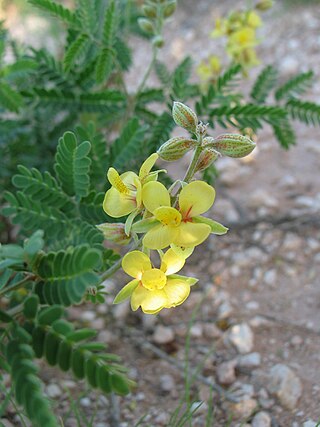
Pomaria jamesii, commonly known as James' holdback, is a species of plant found in the American southwest.
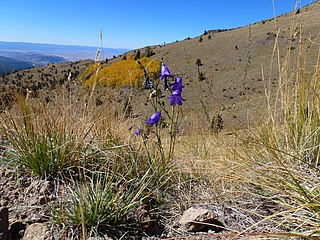
Campanula parryi, or Parry's bellflower, is a plant.
Tetraneuris scaposa is a North American species of flowering plant in the sunflower family. It is native to the southwestern and south-central United States and northern Mexico.
Dysphania graveolens, common name fetid goosefoot, is a plant found from Utah, Arizona and west Texas to Guatemala, Peru and northwest Argentina. It has been introduced elsewhere including the east coast of the United States. It has many synonyms, including Chenopodium graveolens and Dysphania incisa. In 2021, the correct name in Dysphania was said to be Dysphania graveolens, although as of 12 April 2022, Plants of the World Online accepted the unpublished name Dysphania incisa.

Croton texensis,commonly known as Texas croton, goat weed, skunk weed, and doveweed, is a species of plant found in the United States.

Eriogonum alatum, with the common names winged buckwheat and winged eriogonum, is a species of buckwheat.
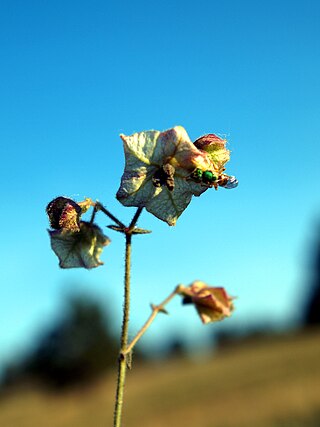
Mirabilis linearis, commonly known as narrowleaf four o'clock, is a species of plant. Among the Zuni people, the root is eaten to induce urination and vomiting. They also take an infusion of the root for stomachache.














